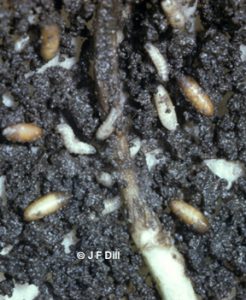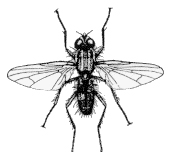Cabbage Maggots
Pest Management Fact Sheet #5005
(Delia radicum)
James F. Dill, Pest Management Specialist
Clay A. Kirby, Insect Diagnostician
For information about UMaine Extension programs and resources, visit extension.umaine.edu.
Find more of our publications and books at extension.umaine.edu/publications/.
 Introduction
Introduction
The cabbage maggot (Delia radicum) is a very destructive insect that attacks crucifers (cool-weather plants) such as cabbage, broccoli, cauliflower, Brussels sprouts, radishes, rutabagas, and turnips. Wilting leaves are usually a sign of maggot damage and indicate that roots need to be checked for maggots and for damage.
Description & Biology
Cool weather is necessary for the cabbage maggot’s emergence, which takes place over a 2 to 3-week period. This extended period of emergence, added to the lifespan of the fly, exposes seedlings and transplants to a 30-day egg-laying period. There are 3 to 4 generations per year.
The insect overwinters as an egg-shaped pupa buried in the soil. Flies first emerge and mate during May. The females deposit their eggs at the base of plants. In 3 to 9 days, the white, tapered, legless maggots (larvae) emerge from their eggs. The maggots move to the root zone where they feed, damaging or sometimes destroying the root system. Larvae feed for 20 to 30 days until they are mature (1/4 to 1/3-inch long) and ready to pupate. The first spring generation is the most damaging. Adult flies emerge in 10 to 14 days. The flies resemble houseflies, but are 1/4-inch long with black stripes on the thorax.
Because of the variation in time of adult emergence in the spring and the variation in length of developmental stages, it is possible for maggots to be present much of the growing season. However, high temperatures and disease suppress populations in July and August. The cooler temperatures of September and October favor development. At that time, the maggots damage fall-maturing plants such as rutabagas, turnips, and Brussels sprouts, as well as other late-season crucifer crops.
- Larval Stage
- Pupal Stage
- Adult (Fly) Stage
Management
It is important to remove roots, root crops and other host plants, and destroy them in the fall. It also helps to remove wild host plants at any time during the year, especially any plants in the Mustard (Cruciferae) family.
Fall tillage may also expose over-wintering pupae to predators and desiccation. Use resistant or maggot-tolerant plant varieties if cabbage maggots have been a problem in previous years. Good soil fertility will help damaged plants overcome injury. Beneficial nematodes can be used to protect new transplants.
There are ways to physically prevent maggots from reaching the root zone. A ‘cabbage collar’ can be fashioned by taking a small piece of plastic or cardboard, cutting a slit to the middle of it, then wrapping it around the plant stem so that it’s snug and overlapping or rising up the stem somewhat to create a bit of a collar, then securing the whole thing in place with tape or soil. Another method uses two pieces of plastic about 12 inches square, pulled together around the plant from opposite sides and held down with soil. Spreading a layer of wood ash or diatomaceous earth around the stems can also be helpful at deterring the flies from laying their eggs. Screening or spunbonded/polyester row cover will keep egg-laying flies off the plants.
When Using Pesticides
ALWAYS FOLLOW LABEL DIRECTIONS!
Pest Management Unit
Cooperative Extension Diagnostic and Research Laboratory
17 Godfrey Drive, Orono, ME 04473
1.800.287.0279 (in Maine)
Information in this publication is provided purely for educational purposes. No responsibility is assumed for any problems associated with the use of products or services mentioned. No endorsement of products or companies is intended, nor is criticism of unnamed products or companies implied.
© 2016, 2018, 2020 | Reviewed/Revised: 2023
Call 800.287.0274 (in Maine), or 207.581.3188, for information on publications and program offerings from University of Maine Cooperative Extension, or visit extension.umaine.edu.
In complying with the letter and spirit of applicable laws and pursuing its own goals of diversity, the University of Maine System does not discriminate on the grounds of race, color, religion, sex, sexual orientation, transgender status, gender, gender identity or expression, ethnicity, national origin, citizenship status, familial status, ancestry, age, disability physical or mental, genetic information, or veterans or military status in employment, education, and all other programs and activities. The University provides reasonable accommodations to qualified individuals with disabilities upon request. The following person has been designated to handle inquiries regarding non-discrimination policies: Director of Equal Opportunity, 101 Boudreau Hall, University of Maine, Orono, ME 04469-5754, 207.581.1226, TTY 711 (Maine Relay System).




